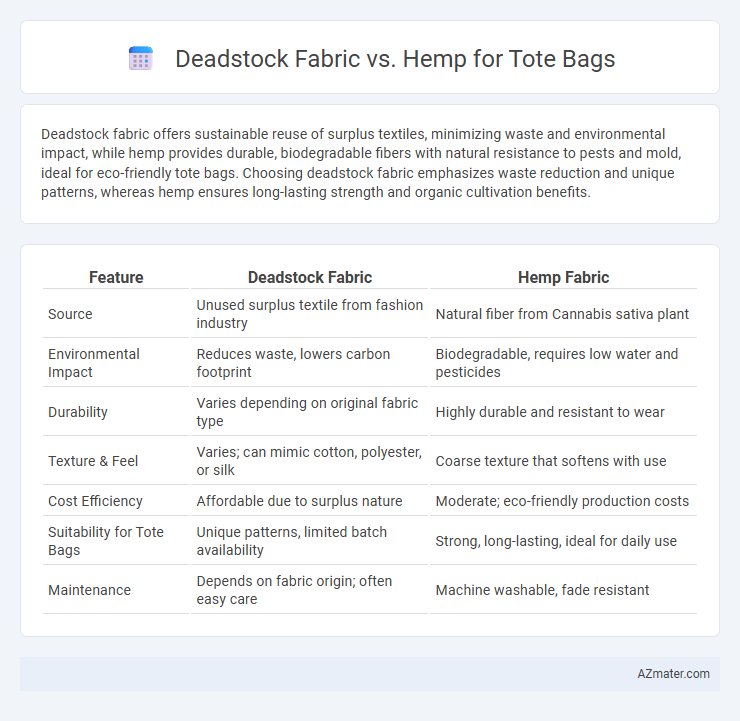Deadstock fabric offers sustainable reuse of surplus textiles, minimizing waste and environmental impact, while hemp provides durable, biodegradable fibers with natural resistance to pests and mold, ideal for eco-friendly tote bags. Choosing deadstock fabric emphasizes waste reduction and unique patterns, whereas hemp ensures long-lasting strength and organic cultivation benefits.
Table of Comparison
| Feature | Deadstock Fabric | Hemp Fabric |
|---|---|---|
| Source | Unused surplus textile from fashion industry | Natural fiber from Cannabis sativa plant |
| Environmental Impact | Reduces waste, lowers carbon footprint | Biodegradable, requires low water and pesticides |
| Durability | Varies depending on original fabric type | Highly durable and resistant to wear |
| Texture & Feel | Varies; can mimic cotton, polyester, or silk | Coarse texture that softens with use |
| Cost Efficiency | Affordable due to surplus nature | Moderate; eco-friendly production costs |
| Suitability for Tote Bags | Unique patterns, limited batch availability | Strong, long-lasting, ideal for daily use |
| Maintenance | Depends on fabric origin; often easy care | Machine washable, fade resistant |
Introduction to Sustainable Tote Bag Materials
Deadstock fabric and hemp are prominent sustainable materials used for eco-friendly tote bags. Deadstock fabric consists of surplus or leftover textiles from previous production runs, reducing textile waste and promoting resource efficiency. Hemp offers durability, natural resistance to mold and UV rays, and requires fewer pesticides and water compared to conventional cotton, making it an excellent biodegradable option for sustainable tote bags.
What is Deadstock Fabric?
Deadstock fabric refers to unused, surplus textile materials leftover from previous fashion production runs or factory overstock, often characterized by high-quality, unique patterns unavailable elsewhere. Using deadstock fabric for tote bags promotes sustainable fashion by reducing waste and minimizing the demand for new textile manufacturing, which is energy and resource-intensive. Unlike hemp, a natural fiber known for its durability and biodegradability, deadstock fabric varies widely in composition and origin, making each tote bag distinct in material and ecological impact.
Understanding Hemp as a Textile
Hemp fabric offers exceptional durability, breathability, and natural resistance to mold and UV light, making it an ideal choice for sustainable tote bags. Its fibers are stronger than cotton, providing a long-lasting, eco-friendly alternative that softens with use without compromising strength. Compared to deadstock fabric, hemp emphasizes renewable cultivation and lower environmental impact, aligning with environmentally conscious fashion and lifestyle choices.
Environmental Impact: Deadstock vs Hemp
Deadstock fabric repurposes surplus textiles, significantly reducing landfill waste and lowering the carbon footprint associated with new fabric production, promoting circular fashion. Hemp cultivation requires minimal water, no pesticides, and absorbs large amounts of CO2, making it a highly sustainable crop with a positive environmental impact. Tote bags made from deadstock fabric conserve resources by extending the life cycle of existing materials, while hemp bags offer durability and biodegradability, resulting in reduced environmental pollution.
Durability and Strength Comparison
Deadstock fabric, made from unused surplus textiles, often offers high durability due to its original manufacturing standards, but its longevity can vary depending on fiber content and weave. Hemp fabric is renowned for exceptional strength and abrasion resistance, making it one of the most durable natural fibers ideal for heavy-duty tote bags. Comparing both, hemp generally surpasses deadstock fabric in tensile strength and wear resistance, ensuring longer-lasting performance under repeated use.
Style and Aesthetic Differences
Deadstock fabric offers unique, vintage patterns and textures that bring a distinctive, one-of-a-kind style to tote bags, often appealing to fashion-conscious consumers seeking exclusive designs. Hemp fabric provides a natural, earthy aesthetic with a slightly coarse texture and muted tones, enhancing a rustic, eco-friendly appearance that resonates with sustainable fashion enthusiasts. The choice between deadstock and hemp fabrics significantly influences the tote bag's visual appeal, balancing originality with environmental values.
Cost Analysis of Deadstock Fabric and Hemp
Deadstock fabric generally offers a cost-effective option for tote bags due to its surplus availability and lower production expenses compared to hemp. Hemp fabric, while more durable and sustainable, often comes with higher raw material and processing costs, leading to increased pricing. Choosing deadstock fabric can reduce upfront costs, but hemp's long-term benefits in durability and eco-friendliness may justify the higher investment for tote bags.
Availability and Sourcing Challenges
Deadstock fabric offers a sustainable advantage by repurposing surplus textiles that would otherwise go to waste, but sourcing consistent quantities can be unpredictable due to limited and irregular supply from fashion industry leftovers. Hemp, grown as a renewable crop with increasing agricultural production, provides a more reliable and scalable source of raw material for tote bags, though its processing infrastructure remains less developed in many regions, posing initial sourcing challenges. Balancing availability, deadstock fabric excels in eco-conscious upcycling efforts, whereas hemp shows promise for long-term material stability amid evolving sustainability trends.
Eco-Friendly Tote Bag Consumer Preferences
Deadstock fabric offers an eco-friendly tote bag option by repurposing leftover textile materials, significantly reducing waste and carbon footprint. Hemp, known for its durability and biodegradability, appeals to consumers seeking sustainable and long-lasting tote bags that require fewer pesticides and less water during cultivation. Preference shifts toward deadstock fabric emphasize circular fashion and upcycled materials, while hemp attracts those prioritizing natural fibers and soil health in their eco-conscious choices.
Choosing the Best Material for Sustainable Totes
Deadstock fabric, sourced from surplus or leftover textiles, minimizes waste by repurposing materials, making it a highly sustainable choice for tote bags. Hemp offers exceptional durability and natural resistance to mold and UV rays, with its cultivation demanding less water and pesticides compared to conventional cotton. Selecting between deadstock fabric and hemp depends on prioritizing waste reduction through reuse or leveraging hemp's eco-friendly growth properties for long-lasting, sustainable totes.

Infographic: Deadstock Fabric vs Hemp for Tote Bag
 azmater.com
azmater.com